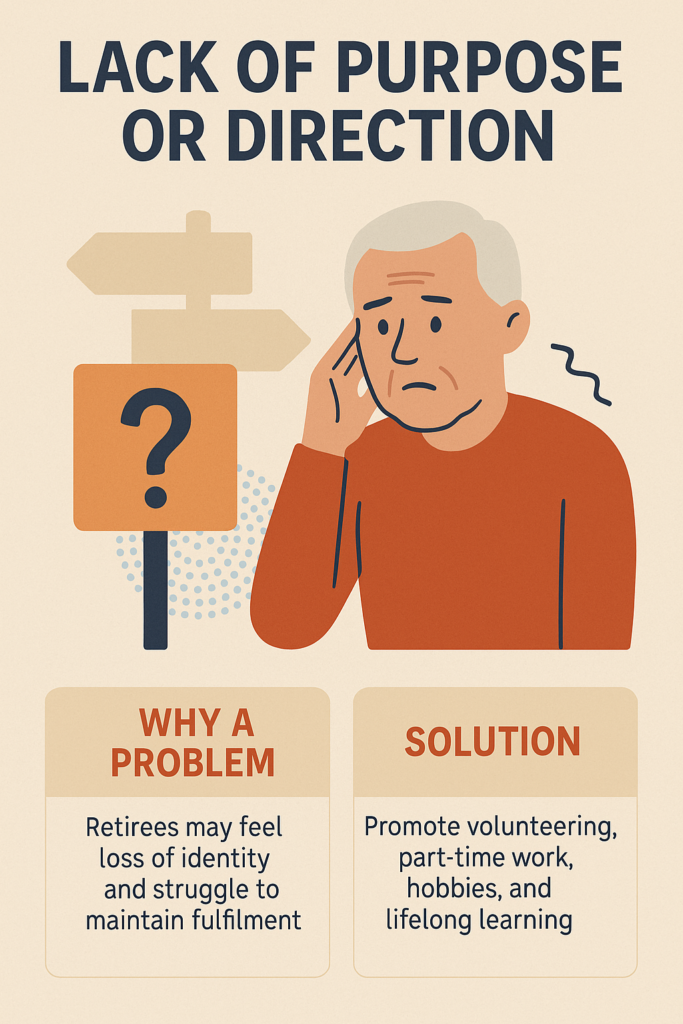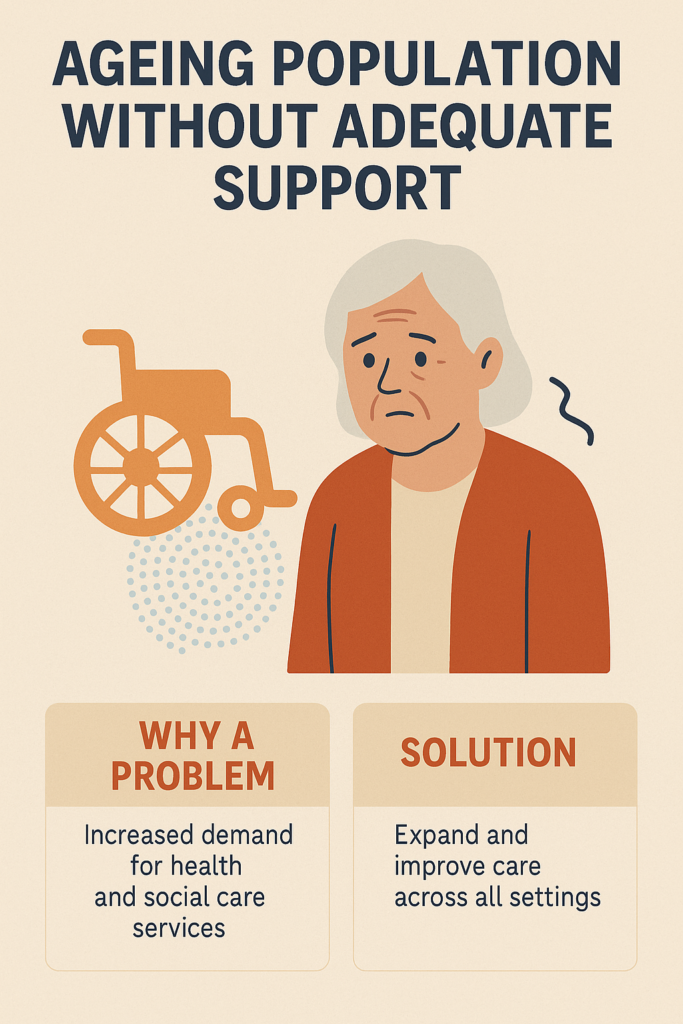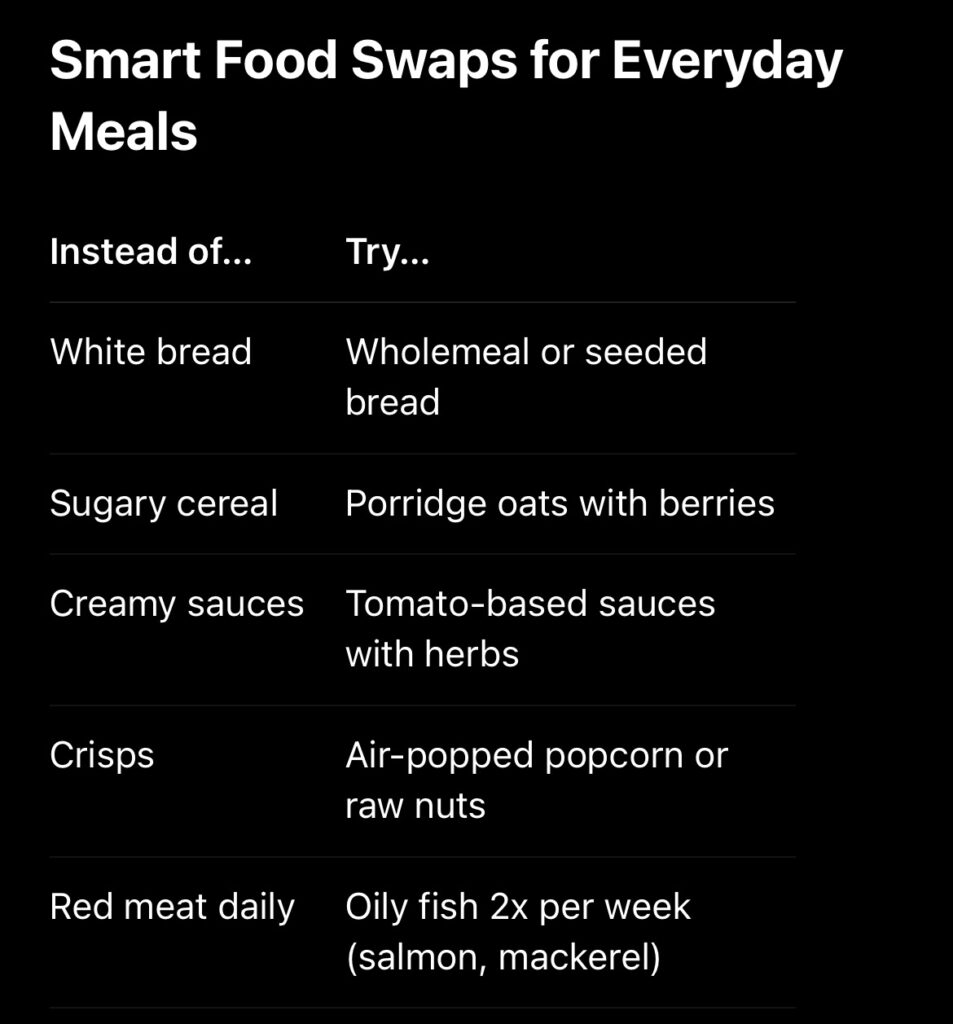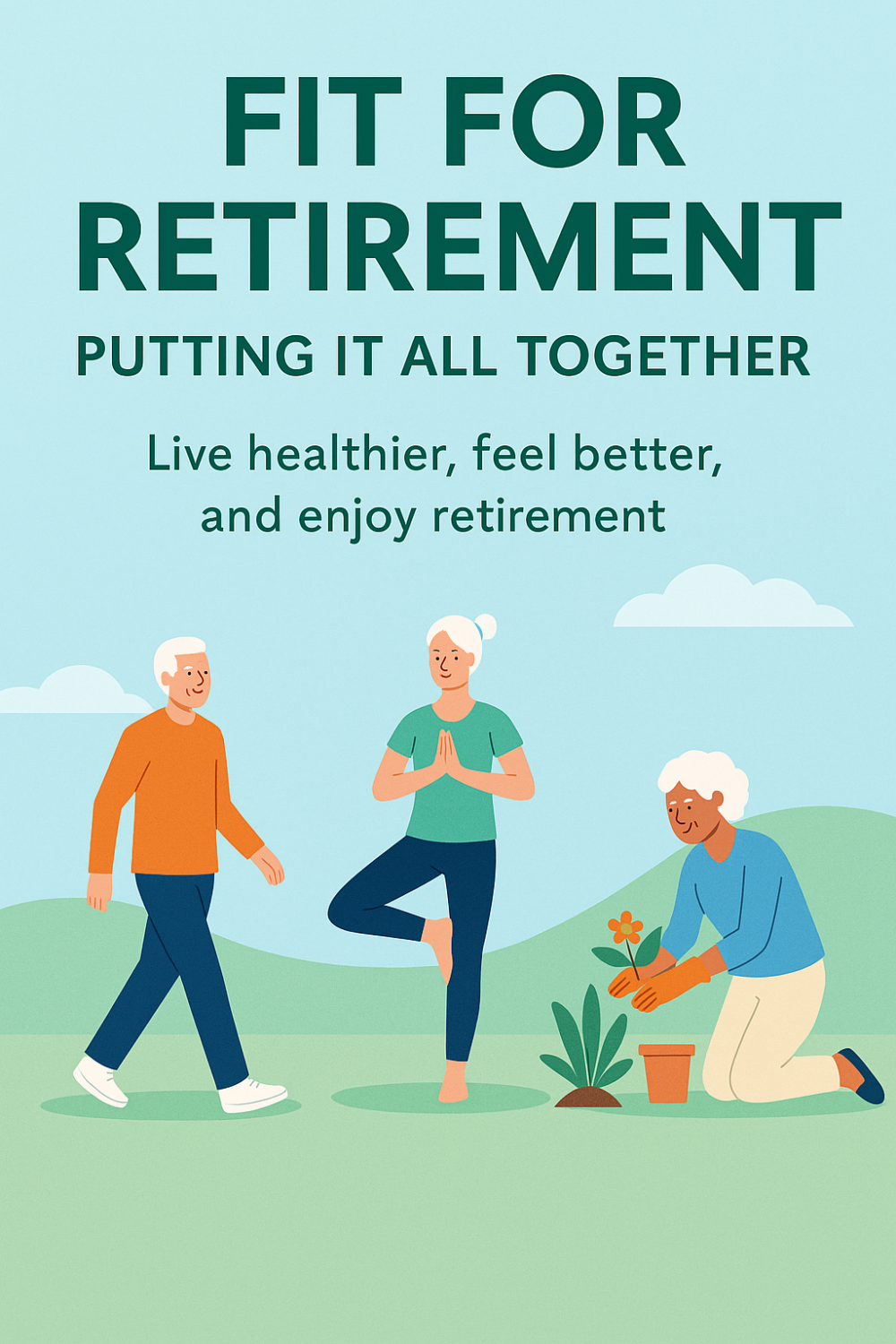Fit for Retirement: A Health and Wellness Guide for the Over 55s UK
Is your essential roadmap to thriving in your later years.
Packed with practical advice, 2025 updates, and UK-specific tips, this ebook helps you boost your physical, mental, and emotional well-being after 55. Whether you’re newly retired or planning ahead, this guide empowers you to stay active, eat better, manage stress, and embrace a more fulfilling lifestyle.
Join thousands of readers improving their quality of life—this isn’t just about living longer, it’s about living better.
Perfect for over 55s ready to make the most of every moment.
Take the first step toward a healthier, happier retirement! Purchasing ebook now grants you discount on Retirement Club One-Off Lifetime Membership giving additional retirement lifestyle improvement exclusive content.
#HealthyRetirementUK #Over55Wellness #FitForRetirement #ActiveAgingUK #BetterLifeAfter55
Note: PDF will be sent by email or website link not post

Table of Contents
- Introduction: Why Health and Wellness Matters After 55
- Understanding the Ageing Body and Mind
- Nutrition for Longevity and Energy
- Fitness After 55: Staying Active Safely
- Mental Wellness and Emotional Resilience
- Preventive Healthcare and Regular Screenings
- Sleep and Recovery: The Missing Piece
- Social Wellness and Connection
- Managing Chronic Conditions
- Creating a Personal Health and Wellness Plan
- Resources and Services in the UK
- Conclusion: Embracing the Healthiest Years of Your Life

Chapter 1: Introduction – Why Health and Wellness Matters After 55
A New Chapter, A New Opportunity
Reaching the age of 55 marks a powerful transition. It’s a stage where life experience, wisdom, and independence intersect with new questions about the future. For many in the UK, 55 is a gateway to retirement planning, downsizing, or finally pursuing long-postponed passions. But it’s also a critical turning point for health and wellness.
People are living longer than ever. According to the Office for National Statistics (ONS), life expectancy in the UK is now over 79 for men and 83 for women. Many can expect to live well into their 90s. The question then becomes: how will those later years look? Will they be spent managing illness and fatigue — or filled with energy, engagement, and enjoyment?
The difference lies in choices made today. That’s where this guide begins.
⸻
The Reality of Health After 55 in the UK
As of 2025, over 22 million people in the UK are aged 50 or older, with those over 55 representing a significant and growing segment of the population. While many over 55 enjoy good health, this is also the age when risks of chronic conditions like type 2 diabetes, high blood pressure, arthritis, and cardiovascular disease start to increase.
The NHS continues to promote healthy aging initiatives, but waiting until problems arise is a reactive approach. The truth is: preventing decline is far easier than reversing it.
Many issues that are often written off as “just aging” — fatigue, brain fog, aches and pains — are frequently the result of poor lifestyle choices that can be changed.
⸻
Why Health and Wellness Should Be a Priority Now
1. Health is Freedom
When you’re in your 30s or 40s, it’s easy to take your body for granted. But after 55, even minor issues can limit what you can do, where you can go, and how you experience the world.
Good health gives you choices — the choice to travel, take care of grandchildren, enjoy hobbies, or start a second career. Without it, those options shrink rapidly.
2. It’s Not Too Late
There’s a common myth that lifestyle changes after a certain age are too little, too late. Nothing could be further from the truth.
Research shows that even small changes after age 55 — like walking more, eating more vegetables, or getting better sleep — can dramatically reduce the risk of chronic disease and even reverse some early signs of decline.
One study published in The Lancet Healthy Longevity in 2024 showed that people aged 55–70 who increased their physical activity to just 150 minutes per week reduced their risk of premature death by 32%, regardless of previous habits.
3. Modern Medicine Meets Preventative Living
The NHS continues to advance in diagnostics, early screenings, and medications. But the biggest shift in 2025 is the focus on lifestyle medicine — using behaviour, not just pills, as the front line of health care.
From social prescribing to wellness coaching on the NHS, the UK is moving toward empowering individuals to take control of their own health.
⸻
What Is “Wellness” Anyway?
The word “wellness” gets thrown around a lot — but what does it actually mean?
True wellness is not just the absence of disease. It’s the presence of energy, purpose, emotional strength, social connection, and the ability to enjoy life. It’s:
• Having the stamina to walk the Scottish Highlands.
• Having the mental focus to learn something new.
• Having the emotional peace to enjoy relationships.
In this guide, health and wellness include the following dimensions:
• Physical Health: fitness, nutrition, sleep, mobility, energy.
• Mental Wellness: stress management, cognitive function, emotional balance.
• Preventative Care: screenings, medical checkups, medications where needed.
• Social Wellness: friendships, community, sense of belonging.
• Purposeful Living: goals, passions, new directions in retirement.
⸻
Understanding the Risks (and How to Beat Them)
Here are some of the top health issues facing people over 55 in the UK — and why a wellness approach can help prevent or manage them.
1. Cardiovascular Disease
• Affects 1 in 5 people aged 55+.
• Linked to high blood pressure, poor diet, inactivity, and stress.
• Lifestyle changes (exercise, diet, stress reduction) are first-line prevention.
2. Type 2 Diabetes
• Increasing rapidly in people over 55.
• Often reversible with weight loss, dietary changes, and more movement.
3. Arthritis and Joint Pain
• Common but not inevitable.
• Anti-inflammatory diets, movement, and strength training help maintain mobility.
4. Dementia and Cognitive Decline
• UK studies (2023–2024) show brain plasticity remains high into our 70s.
• Mental stimulation, healthy fats, sleep, and social engagement all reduce risk.
5. Loneliness and Mental Health
• A silent epidemic, especially among over-55s who live alone or are retired.
• Wellness strategies include joining clubs, volunteering, or pursuing group hobbies.
⸻
Retirement Is Not the End — It’s a Launchpad
For some, the word “retirement” signals slowing down. But for a growing number of over 55s, it’s an opportunity to reinvent, reconnect, and recharge.
Whether you’re planning to retire soon, are already retired, or are still working part-time, your 50s, 60s, and 70s can be some of the most energetic and fulfilling years — but only if your health supports the life you want.
⸻
What This Book Will Help You Achieve
This book is your roadmap to living stronger, longer, and happier. You’ll discover:
• How to eat for energy and longevity without expensive diets.
• Fitness tips tailored to older bodies (and busy schedules).
• Mental wellness practices that reduce stress and improve memory.
• Preventative health steps that work within the NHS system.
• Daily routines that enhance quality of life without overwhelming change.
Each chapter includes practical tips, checklists, and real-life examples from across the UK — from active retirees in Cornwall to healthy walkers in the Highlands.
⸻
Your Next Step
Don’t worry about changing everything overnight. This journey isn’t about perfection. It’s about progress.
Chapter by chapter, we’ll build a sustainable, realistic approach to health and wellness that suits your goals, your schedule, and your body — starting with understanding the unique ways your body changes after 55.
⸻
Next Up: Chapter 2 – Understanding the Aging Body and Mind
Chapter 2: Understanding the Aging Body and Mind
A Time of Transition — Not Decline
Aging doesn’t mean decline. It means change. And with change comes opportunity. For people over 55 in the UK, understanding what’s actually happening in the body and mind during this stage of life is critical to staying in control.
Too often, older adults are led to believe that gaining weight, feeling tired, losing strength, or becoming forgetful are just part of “getting old.” But many of these changes are not inevitable. They are symptoms of outdated habits or neglect — not the passage of time itself.
This chapter will explore the real science of aging as we know it in 2025, and show you how knowledge is power when it comes to health.
What Happens to the Body After 55?
Everyone ages differently, depending on genetics, lifestyle, and environment. But certain physiological changes are common after 55:
1. Muscle Mass Declines (Sarcopenia)
After age 50, people typically lose about 1–2% of muscle mass per year unless they actively work to maintain it.
- Why it matters: Less muscle means less strength, balance, and mobility — and a slower metabolism.
- What helps: Resistance training (even bodyweight), protein-rich diets, and staying active daily.
2. Bone Density Reduces
This is especially true for post-menopausal women due to declining oestrogen levels. Osteopenia and osteoporosis increase fracture risk.
- What helps: Weight-bearing exercise (like walking or dancing), calcium and vitamin D, and regular bone density scans.
3. Metabolism Slows
As we age, our bodies need fewer calories, but not fewer nutrients. This can lead to weight gain, particularly around the middle.
- What helps: Mindful eating, strength training to boost resting metabolism, and avoiding processed sugar.
4. Joint Flexibility and Cartilage Decrease
Arthritis becomes more common after 55, particularly in the knees, hips, and hands.
- What helps: Stretching, anti-inflammatory foods (like oily fish and leafy greens), and low-impact movement (like swimming or yoga).
5. Vision, Hearing, and Balance Can Change
These are subtle changes that affect daily confidence and safety.
- What helps: Regular eye and hearing tests, balance exercises (like tai chi), and environment adaptations at home.
The Ageing Brain: What to Expect and How to Protect It
The brain does change as we age, but not always in the way people expect. Forgetting names occasionally? Normal. Losing interest in new things or withdrawing from others? Not normal.
Common Changes After 55:
- Processing speed slows slightly — reaction times are longer.
- Multitasking becomes harder — but focusing on one thing at a time improves.
- Recall (retrieving information) slows down — but recognition stays strong.
- Emotional regulation often improves — older adults tend to be calmer.
Cognitive Decline Is Not Inevitable
According to a 2024 Alzheimer’s Research UK report, lifestyle factors play a greater role in dementia risk than genetics.
- What helps:
- Regular physical activity.
- Brain challenges (puzzles, learning languages or instruments).
- Social engagement and community involvement.
- A Mediterranean-style diet.
- Managing blood pressure and diabetes.
Hormonal Shifts in Men and Women
Women: Post-Menopause Health Focus
- The average age of menopause in the UK is 51.
- After menopause, oestrogen drops can affect:
- Bone strength.
- Cholesterol levels.
- Sleep and mood.
What helps:
- Exercise, especially resistance training.
- Heart-healthy foods (like oats, berries, olive oil).
- Speaking to a GP about HRT or alternatives.
Men: Andropause or “Male Menopause”
- Testosterone levels drop gradually after 40.
- Some men experience lower libido, energy, or mood changes.
What helps:
- Strength training and cardiovascular exercise.
- Healthy fats and sleep.
- GP consultations for blood tests if symptoms are significant.
Psychological Transitions After 55
While the body shifts, so does your sense of self.
1. Retirement Identity Shift
Many struggle with the transition from work to retirement. The sudden absence of routine or purpose can lead to low mood or anxiety.
Solution: Build a new identity based on what you value, not what you used to do. That could be volunteering, mentoring, or learning.
2. Dealing with Loss
Bereavement, health scares, or caring for a partner are more likely to occur after 55. These life events can cause emotional and physical strain.
Solution: Seek support early. Local NHS services and charities like Age UK and Cruse Bereavement Care offer help.
3. Rediscovering Purpose
This can be one of the most fulfilling psychological changes. With fewer responsibilities, many over 55s rediscover hobbies, passions, or social causes.
The Role of Sleep and Recovery in Ageing Well
Sleep quality often declines after 55 due to hormonal changes, stress, or medical conditions.
- Trouble falling asleep.
- Waking frequently.
- Feeling tired despite hours in bed.
Why it matters: Poor sleep is linked to increased risks of heart disease, obesity, diabetes, and dementia.
What helps:
- Consistent sleep schedule.
- Limiting screen time in the evening.
- Avoiding caffeine and alcohol late in the day.
- Creating a calm bedtime routine.
Your Body, Your Story — Take Control
Many people over 55 feel betrayed by their bodies. But the reality is, your body is still capable of growth, healing, and strength. You simply need to give it the right environment.
Understanding these natural changes means you can respond proactively, not reactively. You don’t need to accept weakness, stiffness, or tiredness as your new normal.
Instead, embrace this chapter as a time to adapt and invest in yourself.
Coming Up Next
In Chapter 3, we’ll get practical with what to eat to fuel your body after 55 — without giving up the pleasure of food.
Chapter 3: Nutrition for Longevity and Energy
Why Food Becomes Even More Important After 55
As we age, our nutritional needs change — not because we need less, but because we need better. After 55, every meal becomes an opportunity to prevent illness, boost energy, protect your brain, and support your immune system.
According to the NHS and the British Dietetic Association (2025), older adults in the UK are increasingly at risk of “hidden hunger” — eating enough calories, but lacking vital nutrients. This chapter explores how to eat for vitality, manage common age-related challenges, and enjoy food as a source of well-being, not just fuel.
The Core Goals of Nutrition After 55
Your ideal diet at this stage should aim to:
- Preserve muscle and support bone strength.
- Maintain a healthy weight while reducing belly fat.
- Support cognitive function and heart health.
- Aid digestion and reduce inflammation.
- Boost energy levels and immune response.
And it must do all this while still being enjoyable, realistic, and affordable.
The Essentials: What Your Body Needs More Of
1. Protein
After 55, protein is critical to protect muscle mass and bone density.
- Target: 1.0 to 1.2 grams per kilogram of body weight daily.
- Best sources: Eggs, poultry, fish, tofu, lentils, beans, Greek yoghurt, milk, and lean red meat.
Quick Tip: Spread your protein across meals. Don’t save it all for dinner.
2. Fibre
Digestion slows with age. Fibre supports regular bowel movements and helps lower cholesterol.
- Target: At least 30g per day.
- Best sources: Oats, whole grains, fruits (especially berries and apples), vegetables, legumes, nuts, and seeds.
Quick Tip: Increase fibre slowly and drink more water to avoid bloating.
3. Healthy Fats
The right fats reduce inflammation and support brain health.
- Best sources: Olive oil, avocado, oily fish (like salmon, mackerel, sardines), walnuts, and flaxseeds.
Avoid trans fats and reduce saturated fats (like those in pastries and processed meats).
4. Calcium and Vitamin D
Essential for bone health, especially post-menopause.
- Calcium sources: Dairy, fortified plant milks, leafy greens, sardines (with bones).
- Vitamin D: The UK government recommends all adults over 55 take a 10 mcg supplement daily from October to March.
5. B Vitamins and Omega-3s
- B12: Needed for energy and nerve function. Absorption decreases with age. Found in meat, dairy, and fortified cereals.
- Omega-3s: Found in oily fish, flaxseeds, walnuts — crucial for heart and brain health.
Consider: Supplements if your intake is low, especially for B12 and Omega-3s.
What to Limit or Avoid
- Refined sugar: Linked to weight gain, insulin resistance, and inflammation.
- Highly processed foods: These often contain hidden salt, sugar, and unhealthy fats.
- Too much alcohol: Affects sleep, liver, and mood. The NHS recommends no more than 14 units per week — ideally spread out over 3+ days.
Sample One-Day Meal Plan for Over 55s (UK)
Breakfast:
- Porridge made with semi-skimmed milk or fortified oat milk
- Topped with berries, ground flaxseed, and a spoon of Greek yoghurt
Mid-Morning Snack:
- A boiled egg and a handful of cherry tomatoes
Lunch:
- Grilled salmon salad with rocket, avocado, chickpeas, and olive oil dressing
- Whole grain bread on the side
Afternoon Snack:
- A small handful of unsalted nuts
- A cup of green tea
Dinner:
- Stir-fry with chicken breast or tofu, broccoli, carrots, and brown rice
- Flavoured with ginger, garlic, and sesame oil
Evening:
- Herbal tea and a square of 70% dark chocolate
Managing Common Challenges After 55
Slower Digestion?
- Eat smaller meals more frequently.
- Add probiotics (e.g., kefir or yoghurt).
- Increase daily walking.
Poor Appetite?
- Add herbs, spices, and citrus to boost taste.
- Eat nutrient-dense mini-meals (like soup with lentils or smoothies with protein powder).
Budget Concerns?
- Buy frozen fruits and vegetables.
- Use tinned fish (like sardines) for omega-3s.
- Batch-cook meals and freeze portions.
Staying Hydrated
Hydration is often overlooked but becomes more vital after 55. Even mild dehydration can cause fatigue and confusion in older adults.
- Aim: 6–8 glasses of water a day.
- Also count: herbal teas, milk, and soups.
Watch out: Relying on thirst alone may not be enough. Make it a habit.
Joyful Eating: Your Relationship with Food
Food is more than nutrition — it’s also emotional, social, and cultural. In 2025, there’s a shift toward mindful eating, where meals are savoured, not rushed.
- Eat without screens.
- Focus on flavour and texture.
- Share meals with others when possible.
Mindful eating improves digestion, reduces overeating, and makes meals more fulfilling.
Summary: Eat Well, Age Better
You don’t need to follow fads or cut out food groups. Instead, aim for balance, variety, and consistency. Your 55+ body will thank you with more energy, stronger bones, and a clearer mind.
Eating well is not about discipline — it’s about self-respect and future-proofing your lifestyle.
Coming Up Next
In Chapter 4, we’ll move from the kitchen to the gym, park, or living room — wherever you prefer to move — and explore how to stay fit and active safely after 55.
Chapter 4: Staying Active — Exercise That Works for Over 55s
Why Movement Matters More Than Ever
After 55, physical activity isn’t just about looking good — it’s about maintaining independence, preventing illness, and enhancing quality of life. According to the NHS and UK Active (2025), just 30 minutes of moderate activity most days can:
- Reduce your risk of heart disease, stroke, type 2 diabetes, and cancer
- Improve balance and flexibility, reducing falls
- Enhance memory, mood, and mental health
- Protect joints and bones
- Help maintain a healthy weight
Exercise truly is medicine — and it’s never too late to start.
Common Myths About Exercise Over 55
“I’m too old to start now.”
Wrong. Studies show that people starting exercise in their 60s or even 70s gain major health improvements.
“Exercise is too risky for me.”
With proper guidance and warm-up routines, exercise reduces injury and fall risk — it doesn’t increase it.
“I have arthritis or chronic pain — I can’t move much.”
Gentle, low-impact movement like swimming, tai chi, or walking can actually reduce stiffness and pain.
The 4 Pillars of Fitness for Over 55s
1. Cardiovascular Exercise
(for heart and lungs)
Goal: 150 minutes of moderate-intensity cardio per week (e.g., brisk walking, cycling, dancing)
Great options:
- Brisk walks in the park or along coastal paths
- Cycling on flat terrain
- Swimming or aqua aerobics
- Dancing (in a class or at home with music)
- Gardening or active housework
2. Strength Training
(to protect muscle and bones)
Goal: 2 days per week of resistance exercises
Why it matters:
After age 50, we lose 1–2% of muscle mass per year if we don’t train. Resistance training helps:
- Prevent falls
- Support metabolism
- Maintain independence in daily tasks
Simple strength options:
- Bodyweight exercises (squats, wall push-ups, step-ups)
- Resistance bands (affordable and portable)
- Light hand weights or tins of food
- Pilates or yoga with strength focus
Tip: You don’t need a gym. Strength training can be done at home in under 30 minutes.
3. Flexibility and Balance
(to stay agile and safe)
Goal: Stretching or mobility exercises 3–5 times per week
Top choices:
- Yoga (especially classes designed for seniors)
- Tai Chi (proven to improve balance and reduce falls)
- Daily stretching routine after waking or before bed
Try this 3-minute routine:
- Neck rolls
- Shoulder shrugs
- Gentle hamstring stretch
- Standing calf stretch
- Ankle circles
4. Everyday Functional Movement
Not all activity needs to feel like “exercise.” Walking up stairs, playing with grandchildren, doing the shopping — it all adds up.
Tip: Use a pedometer or fitness app to track steps. Aim for 6,000–8,000 steps a day (adjust to your ability).
Home vs. Gym vs. Outdoors
- Home: Great for convenience. Try YouTube workouts for over 55s or NHS Fitness Studio online.
- Gym: Provides structure and equipment. Look for classes tailored to your age group — many gyms now offer “Active 55” or “Forever Fit” sessions.
- Outdoors: Walking groups, hiking, golf, or community park fitness classes offer movement plus fresh air and social contact.
Overcoming Common Barriers
“I Don’t Have Time”
Start small — even 10 minutes a day is beneficial. Build up gradually. Habit is more important than intensity.
“I’m Not Motivated”
Try exercising with a friend or joining a group. Put exercise into your schedule like an appointment. Use music, podcasts, or audiobooks to make it more fun.
“It’s Raining — Again”
Welcome to the UK! Invest in good waterproofs and shoes. Or do home-based routines when weather blocks your usual walk.
Real-Life Examples: Active Over 55s in the UK
Pam, 62, from Devon
Started doing seated strength workouts on YouTube during lockdown and now lifts light weights twice a week — “My knees feel better, and I sleep more deeply.”
George, 70, from Manchester
Joined a local walking football club. “I get my heart pumping, and I’ve made new mates. Best decision I’ve made since retiring.”
Sheena, 58, from Fife
Practices yoga 4 times a week to ease arthritis. “My joints are more flexible, and it’s helped my mental health too.”
Staying Safe: Exercise Tips for Over 55s
- Warm up and cool down properly
- Wear suitable, supportive footwear
- Stay hydrated
- Know your limits — if something hurts, stop
- Talk to your GP if starting from a sedentary lifestyle or managing a health condition
Summary: Move Your Way, Every Day
You don’t have to run marathons or join a bootcamp. But daily movement — tailored to you — is non-negotiable for aging well. The key is consistency, enjoyment, and listening to your body.
Exercise in your 50s, 60s, 70s and beyond isn’t about performance — it’s about freedom.
Coming Up Next
In Chapter 5, we explore the mind-body connection and why mental wellness is just as essential as physical fitness after 55.
Chapter 5: Mental Wellness and Emotional Health Over 55
Why Mental Health Matters More As We Age
After 55, our lives shift in many ways — careers slow down, families evolve, and bodies change. While much of the focus tends to fall on physical health, mental and emotional wellness is equally crucial. In fact, the World Health Organization (2025) reports that one in four people over 60 experiences mental health challenges, often in silence.

Good mental health isn’t just about avoiding depression or anxiety. It’s about resilience, emotional balance, purpose, and social connection — key pillars of a fulfilling retirement.
Common Mental Health Challenges After 55
Understanding what to look out for is the first step to improving your mental wellness.
1. Loneliness and Social Isolation
- Over 50% of people over 55 in the UK report feeling lonely at least some of the time (Age UK, 2025).
- Retirement, bereavement, or children moving away can shrink social circles.
Solution: Reconnect intentionally. Join hobby groups, volunteer, or explore digital communities.
2. Depression
Often underdiagnosed in older adults, symptoms can include low mood, loss of interest, fatigue, and sleep issues. It’s not a normal part of aging — and it’s treatable.
Solution: Seek help early. Talk to your GP or explore NHS talking therapy services.
3. Anxiety
Worries about health, finances, or the future can fuel anxiety in later life.
Solution: Grounding techniques, breathwork, and structured routine can help. Cognitive Behavioural Therapy (CBT) is highly effective.
Strengthening Your Mind in Daily Life
1. Stay Connected
People with strong social ties are 40% less likely to develop cognitive decline.
- Make regular phone or video calls with family and friends.
- Join in-person clubs (like U3A, walking groups, or Men’s Sheds).
- Consider volunteering — helping others boosts your own wellbeing.
2. Keep Learning
Mental stimulation maintains brain plasticity and slows cognitive decline.
- Learn a new language or musical instrument
- Try a new creative hobby — photography, painting, or crafting
- Use apps like Lumosity or do puzzles and crosswords regularly
Tip: Adult learning classes are widely available across the UK and often discounted for over 55s.
3. Mindfulness and Meditation
Practicing mindfulness just 10 minutes a day reduces stress, enhances sleep, and improves focus.
Try this basic practice:
- Sit comfortably with your eyes closed.
- Focus on your breathing — the sensation of air entering and leaving your nose.
- When your mind wanders (it will), gently bring it back to your breath.
Apps like Headspace, Calm, and Balance now offer free or reduced rates for seniors.
The Power of Purpose
Studies show that people who feel a sense of purpose live longer and healthier lives. After retirement, this purpose may shift — but it’s still essential.
Ask yourself:
- What makes me feel useful?
- What do I enjoy doing so much that I lose track of time?
- How can I give back to others or share my experience?
Ideas:
- Mentoring younger professionals
- Starting a blog, podcast, or photo journal
- Helping in your community or faith group
Emotional Fitness: Building Resilience
Emotional resilience is your ability to bounce back from challenges. Like physical strength, it can be built with practice.
Strategies:
- Reframe negative thoughts
- Practice gratitude (e.g., writing 3 things you’re thankful for daily)
- Accept what you can’t control — and take action where you can
- Prioritise rest and healthy boundaries
Sleep, Mood, and the Mind
Sleep patterns can change after 55 — often resulting in lighter or shorter sleep.
To improve sleep quality:
- Go to bed and wake up at the same time each day
- Avoid screens 1 hour before bed
- Cut down on caffeine and alcohol in the evening
- Create a relaxing bedtime routine (e.g., warm bath, herbal tea, soft music)
Better sleep improves memory, mood, and emotional stability.
Real Voices: Emotional Wellness Stories
Eileen, 66, from Newcastle
“I started journaling every morning after my partner died. It helped me feel heard — even just by myself.”
Rob, 72, from Kent
“I joined a book club and learned more about life in a few months than I did in years. Talking with others makes a difference.”
Naz, 59, from Birmingham
“Yoga helped me manage anxiety. I breathe more calmly now, even in stressful situations.”
Summary: A Healthier Mind for a Better Life
Mental and emotional wellbeing is not a luxury — it’s foundational. Prioritising it in your 50s, 60s and beyond is an investment in the years ahead. Whether through stronger relationships, new skills, or greater peace of mind, taking care of your mental health will make every other part of your life richer.
Coming Up Next
In Chapter 6, we’ll explore how your social life and support network shape your health, happiness, and how well you age.
Chapter 6: The Role of Social Connections in a Healthy Retirement
The Surprising Health Power of Friendship
In 2025, studies by Public Health England and Age UK reinforce what many instinctively know: social connections are as vital to your health as diet and exercise. In fact, being socially isolated can be as harmful as smoking 15 cigarettes a day.

As we get older, maintaining friendships and support networks becomes more than a pleasure — it becomes a lifesaving strategy for better health, mental sharpness, and longevity.
Why Social Bonds Are Critical After 55
- Mental Health: Strong social ties reduce the risk of depression and anxiety.
- Cognitive Health: Regular interaction helps keep the brain active and responsive.
- Physical Health: Those with a solid social network tend to recover more quickly from illness and are more likely to stay physically active.
- Longer Life: A 2025 study by the UK Centre for Ageing Better found that older adults with rich social lives live, on average, 7 years longer than those who are isolated.
Common Social Challenges After Retirement
Retirement often brings a loss of daily interaction — no more chats with colleagues, team meetings, or work events. Add to that:
- Children moving away
- Loss of a partner or close friends
- Limited mobility or transport options
- Feeling “out of place” in younger social settings
It’s easy to unintentionally drift into isolation.
Rebuilding and Expanding Your Social Network
The good news: You can actively grow and strengthen your support system at any age.
1. Rekindle Old Friendships
Reach out to friends you may have lost touch with. A quick message or call can rekindle a valuable connection.
2. Join Local Groups
Look for community centres, hobby groups, or clubs in your area. Options include:
- U3A (University of the Third Age)
- Walking clubs or Ramblers groups
- Faith-based groups
- Choirs, knitting circles, art classes
3. Volunteer
Helping others is a powerful way to meet people and gain purpose. Explore opportunities via:
- Do-it.org
- Local libraries or food banks
- NHS or Age UK volunteering networks
4. Attend Community Events
Markets, exhibitions, open mic nights, and social meetups can break up routine and lead to meaningful interactions.
Digital Connection Counts Too
In today’s world, being digitally connected is often the gateway to staying socially connected.
- Video chats with distant friends and family
- Facebook groups or local online forums (e.g., Nextdoor, Meetup.com)
- Online clubs (virtual book clubs, exercise classes, hobby groups)
Not confident online? Free training is available via libraries and community digital inclusion schemes.
Real-Life Examples of Social Wellness
Jean, 67, from Liverpool
“I joined a local photography club. I’d never picked up a camera before retirement, and now I’ve got a new hobby and a new group of mates.”
Colin, 71, from Somerset
“I felt lonely after my wife passed. Volunteering at the community café gave me a reason to get up in the morning — and a new social circle.”
Mira, 58, from London
“I created a WhatsApp group for neighbours over 50. We swap advice, recipes, and meet once a week for a walk.”
Practical Steps to Strengthen Social Wellness
- Make one social plan per week — coffee, phone call, or meet-up
- Smile and start conversations — even small talk builds rapport
- Be open to friendships with different age groups
- Say “yes” more often to invitations, even if you’re unsure
- Create regular traditions — a monthly lunch or shared walk builds momentum
Summary: We’re Healthier Together
You don’t need a huge social circle — just a few meaningful connections can transform your retirement. Prioritising people, conversation, and connection is as powerful for your health as any pill, superfood, or workout.
Coming Up Next
In Chapter 7, we turn to an essential topic: Nutrition After 55 — Fueling a Long, Healthy Life.
Chapter 7: Nutrition After 55 — Fueling a Long, Healthy Life
Why Nutrition Becomes Even More Important With Age
After 55, your body’s needs begin to change. You may need fewer calories but more nutrients to maintain energy, strength, and good health. A balanced diet helps prevent illness, manage chronic conditions, and improve how you feel day to day.
In 2025, NHS guidelines emphasise nutrient-dense meals that support bone health, heart function, brain performance, and digestion — all crucial for ageing well.
Common Nutritional Challenges Over 55
- Slower metabolism: You may burn fewer calories, but your body still needs key nutrients.
- Changes in appetite: Hormones and medications can affect hunger levels or taste preferences.
- Dental issues: Difficulty chewing or swallowing can reduce food variety.
- Absorption issues: Some nutrients (like B12, calcium, and vitamin D) are harder for older bodies to absorb.
Ignoring these challenges can lead to fatigue, weakened immunity, bone loss, and cognitive decline.
The Building Blocks of a Healthy Over-55 Diet
1. Protein: Muscle Maintenance and Repair
- Supports muscle mass, immune function, and recovery
- Aim for: lean meat, fish, eggs, legumes, tofu, and dairy
Example: Add a boiled egg or cottage cheese to your salad.
2. Fibre: Gut Health and Cholesterol Control
- Supports digestion and reduces constipation risk
- Aim for: whole grains, beans, fruit, veg, nuts, and seeds
Example: Switch to wholemeal bread or oats for breakfast.
3. Calcium and Vitamin D: Strong Bones and Teeth
- Vital to prevent osteoporosis and fractures
- Aim for: milk, cheese, yoghurt, leafy greens, fortified foods, and safe sunlight exposure (10–20 mins daily)
Tip: Over-65s should consider a daily 10 microgram Vitamin D supplement, especially in winter.
4. Healthy Fats: Brain and Heart Support
- Opt for unsaturated fats from avocados, oily fish, olives, seeds, and nuts
- Limit saturated fats (butter, cream, fatty meats)
Example: Snack on a handful of almonds instead of biscuits.
5. Hydration: Energy and Digestion
- Older adults often don’t feel thirsty but still need at least 6–8 glasses of fluid per day
- Water, herbal teas, and soups all count
The UK’s Eatwell Guide for Over 55s (2025 Adaptation)
The Eatwell Guide provides a visual breakdown of what your daily plate should look like:
- 1/3 fruit and veg
- 1/3 whole grains and starchy carbs
- 1/6 protein (plant or animal-based)
- 1/6 dairy or calcium-rich alternatives
- Small amounts of healthy fats
Tip: Portion sizes matter more than ever. Use smaller plates and be mindful when eating.

Meal Planning for Energy and Ease
Planning meals helps avoid poor food choices and saves money. Try:
- Batch cooking: Make soups, stews, and casseroles in bulk
- Frozen veg: Just as nutritious and cuts prep time
- Cook once, eat twice: Roast extra veggies for next day’s salad or soup
Example day of eating:
- Breakfast: Porridge with banana and walnuts
- Lunch: Grilled chicken and avocado salad with wholemeal roll
- Snack: Apple with peanut butter
- Dinner: Baked salmon, new potatoes, steamed broccoli
- Hydration: Herbal tea, water, low-fat milk
Nutrition Myths for Over 55s — Busted
- “I need fewer nutrients because I eat less.”
You need more nutrient-rich foods, not fewer. - “Supplements replace food.”
Supplements should only top up gaps in your diet — not be the main source. - “Eating healthy is expensive.”
Frozen veg, tinned fish, beans, and seasonal produce are affordable and nutritious.
Special Dietary Considerations
- Diabetes: Focus on slow-release carbs and limit sugar
- High blood pressure: Reduce salt and processed foods
- Arthritis: Anti-inflammatory foods like oily fish, berries, and turmeric can help
- High cholesterol: Increase soluble fibre and cut down on trans fats
Speak with your GP or a registered dietitian for personalised advice.
Real Stories: Nutrition That Transforms
Gillian, 60, from Glasgow
“I cut down on sugar and added more protein. Within weeks, I had more energy and fewer cravings.”
Martin, 68, from Bath
“My knees ached constantly. Since I started adding oily fish and turmeric to my meals, the inflammation’s gone down.”
Summary: Eat Well to Age Well
Eating healthily after 55 isn’t about restriction — it’s about nourishing your body for vitality. With the right choices, food becomes a powerful tool for living longer, moving better, and feeling your best every day.
Coming Up Next
In Chapter 8, we’ll explore Staying Active: Tailored Fitness for Over 55s, including practical ways to move more and reduce injury risk.
Chapter 8: Staying Active — Tailored Fitness for Over 55s
Why Movement Matters More After 55
As we age, physical activity becomes less about performance and more about preservation — of independence, strength, balance, and quality of life. The 2025 NHS guidelines stress that being active is one of the most important things you can do to maintain your health and mobility.
Regular movement helps to:
- Lower the risk of heart disease, stroke, and type 2 diabetes
- Improve mental health and reduce depression or anxiety
- Boost bone strength and prevent falls
- Maintain flexibility, joint mobility, and coordination
- Preserve muscle mass, aiding independence into your 70s, 80s, and beyond
You don’t need to become a gym addict. Small, consistent activity adds up — and it’s never too late to start.
How Much Exercise Should Over 55s Get?
According to 2025 NHS and World Health Organization recommendations:
- 150 minutes of moderate-intensity aerobic activity weekly (e.g. brisk walking, cycling, swimming)
- 2+ days per week of strength training (e.g. resistance bands, bodyweight exercises)
- Daily balance and flexibility exercises (e.g. yoga, Tai Chi, heel-to-toe walking)
Not sure where to begin?
Even 10-minute blocks of activity make a difference. The goal is to reduce sedentary time and move in ways that feel good and are sustainable.
Common Barriers — and How to Overcome Them

Building a Balanced Routine
1. Cardiovascular Exercise (Heart Health & Endurance)
Examples: brisk walking, swimming, dancing, water aerobics, cycling
- Aim for: 30 minutes, 5 times per week
- Benefits: improves stamina, circulation, and lung function
2. Strength Training (Muscle & Bone Health)
Examples: resistance bands, bodyweight squats, wall push-ups, lifting light weights
- Aim for: 2 sessions weekly
- Benefits: prevents muscle loss, supports bone density, enhances posture and joint health
3. Flexibility & Balance (Preventing Falls)
Examples: yoga, Tai Chi, stretching routines, balance drills (standing on one leg)
- Aim for: daily or at least 3x per week
- Benefits: reduces stiffness, improves coordination, and supports daily activities
Everyday Movement That Counts
You don’t need fancy equipment. Lifestyle movement is powerful:
- Walk the dog or join a Ramblers group
- Dance around the kitchen to music you love
- Use the stairs instead of the lift
- Do a “standing phone call” or walk while on a call
- Garden, wash the car, or clean with enthusiasm
- Join local walking football or pickleball groups
Even gentle movement like chair yoga or stretching contributes to better mobility.
Staying Safe While Exercising
- Start slow: Increase intensity and duration gradually
- Warm up and cool down: Prevents injury
- Stay hydrated: Before, during, and after activity
- Listen to your body: Mild soreness is okay, pain is not
- Check with your GP: Especially if you have underlying conditions or haven’t exercised in a while
Real Stories: How Fitness Changed Lives
Denise, 59, from Nottingham
“I started with 10-minute walks. Now I’m doing weekly dance fitness and feel stronger than I did at 40.”
Ravi, 64, from Leicester
“After my heart scare, I joined a local walking group. I’ve lost weight, gained confidence, and made friends.”
Elaine, 72, from Cardiff
“I do chair yoga on YouTube every morning. It’s helped my back and keeps me grounded.”
Free Resources to Help You Get Started (UK, 2025)
- NHS Fitness Studio
- 10 Today Exercise Programme — designed for over 60s
- Age UK Fitness Classes — check your local branch
- Local leisure centres and councils offer reduced-cost classes for older adults
Summary: Motion is Medicine
Movement is one of the most powerful ways to protect your health after 55. It’s not about hitting the gym — it’s about building a routine that keeps you active, mobile, and confident in your body for years to come.
Even better, exercise often leads to more social connections, improved sleep, and a brighter mood — a true lifestyle win.
Coming Up Next
In Chapter 9, we’ll focus on another core area of wellness: Sleep and Stress — Resetting Your Mind and Body for Better Living.
Chapter 9: Sleep and Stress — Resetting Your Mind and Body for Better Living
Why Sleep and Stress Management Are Crucial After 55
As we age, our ability to bounce back from poor sleep or prolonged stress declines. Sleep becomes lighter, more fragmented, and stress can hit harder — especially in retirement, post-career transitions, or during caregiving responsibilities.
In 2025, NHS research continues to show that poor sleep and unmanaged stress in over 55s contribute to:
- Weakened immune systems
- Increased risk of heart disease and stroke
- Weight gain and type 2 diabetes
- Memory problems and slower cognitive performance
- Anxiety, depression, and emotional burnout
Mastering sleep and managing stress aren’t luxuries — they’re essentials for a healthy, longer, and more fulfilling life.
How Sleep Changes After 55
You might notice:
- Waking up more often at night
- Trouble falling asleep or staying asleep
- Feeling less rested even after 7–8 hours
- Earlier bedtimes and wake-ups (circadian rhythm shifts)
These changes are normal, but quality sleep is still vital for brain function, hormone regulation, cell repair, and mood stability.
How Much Sleep Do You Need?
Most over 55s need 7 to 9 hours of good-quality sleep per night. But consistency matters more than duration. Poor sleep over time increases the risk of chronic illnesses.
Tips for Better Sleep — The 2025 Sleep Hygiene Guide
1. Stick to a Sleep Schedule
- Go to bed and wake up at the same time daily — even on weekends
2. Create a Sleep-Friendly Bedroom
- Keep the room dark, quiet, and cool (16–18°C ideal)
- Invest in blackout curtains and earplugs if needed
- Use your bed for sleep and intimacy only — avoid TV or work
3. Wind Down Properly
- Avoid screens 1 hour before bed (blue light disrupts melatonin)
- Try gentle stretching, reading, or warm baths
4. Watch What You Eat and Drink
- Avoid caffeine after 2pm and limit alcohol
- Eat lighter in the evening; spicy or heavy meals can disrupt sleep
5. Limit Daytime Naps
- If needed, nap for no more than 30 minutes, before 3pm
Natural Sleep Aids for Over 55s
- Herbal teas: Chamomile, valerian root, or lemon balm
- Magnesium-rich foods: Almonds, spinach, bananas
- Melatonin supplements: Use only if recommended by a GP
Note: Always speak with a doctor before starting supplements, especially if you’re on medication.
Understanding Stress After 55
Later life brings different stress triggers:
- Retirement uncertainty
- Financial or health worries
- Loss of loved ones
- Caring for ageing parents or grandchildren
- Loneliness or identity shifts
Unmanaged stress can cause inflammation, raise blood pressure, impair memory, and contribute to burnout.
Practical Stress Management Techniques
1. Mindfulness and Meditation
- Try guided sessions via Calm, Headspace, or free NHS audio practices
- Just 10 minutes per day can reduce anxiety and improve focus
2. Deep Breathing and Relaxation
- Try the 4-7-8 method: Inhale 4 seconds, hold 7, exhale 8
- Progressive muscle relaxation (PMR) helps reduce tension
3. Movement
- Walk outdoors in nature
- Try gentle yoga or Tai Chi for stress reduction and mobility
4. Creative Expression
- Journaling, music, art, or puzzles can relax your mind and increase joy
5. Social Support
- Talk to a trusted friend or join a support group
- Even a weekly cuppa and chat can reduce stress levels
Real-Life Reset Stories
June, 67, from Brighton
“After retiring, I couldn’t sleep for months. I started doing a bedtime meditation, and now I sleep through most nights.”
Trevor, 73, from Derby
“I joined a local men’s shed. It’s made a huge difference to how I handle stress — and I’ve made friends too.”
Moira, 61, from Glasgow
“I do 10 minutes of journaling every morning. It clears my head and starts my day with calm.”
Free Stress & Sleep Support in the UK (2025)
- NHS Sleep Self-Help Toolkit: www.nhs.uk/sleep-help
- Mind (mental health charity): Free guides on stress relief
- SilverCloud: Free online CBT for NHS patients in some areas
- Age UK Befriending Services: For loneliness and emotional support
Summary: Rest and Reset for Wellness
Great sleep and healthy stress management are cornerstones of wellness after 55. Together, they improve your energy, emotional resilience, physical health, and outlook on life. Prioritising sleep and emotional balance is not selfish — it’s sustainable self-care.
Coming Up Next
In Chapter 10, we’ll conclude your wellness journey with Putting It All Together — Your Personal Wellness Plan for Retirement and Beyond.
Chapter 10: Putting It All Together — Your Personal Wellness Plan for Retirement and Beyond
Why You Need a Wellness Plan
Crossing into your 50s, 60s, or 70s doesn’t mean slowing down — it means living smarter, healthier, and more intentionally. A personal wellness plan gives you a sense of purpose, structure, and confidence. It’s your road map to staying fit for retirement — physically, mentally, and emotionally.
You’ve now explored the key pillars of health in this book:
- Mindset and purpose
- Nutrition
- Movement
- Sleep
- Stress management
- Preventative healthcare
- Social connection
Now it’s time to put it all into action in a plan that suits you.
What a Good Wellness Plan Includes
A strong personal health and wellness plan covers:
- Daily health habits
- Weekly and monthly goals
- Check-ins and adjustments
- Support and motivation systems
- Flexibility for real life
It’s not about perfection — it’s about progress. Consistency over intensity.
Step 1: Set SMART Wellness Goals
Make goals that are:
- Specific: “Walk for 20 minutes a day”
- Measurable: “Eat five servings of veg daily”
- Achievable: “Try yoga twice a week”
- Realistic: “Reduce sugar intake by half in one month”
- Time-based: “Lose 4 lbs in 8 weeks, not 2 stone in 1”
Example SMART Goal:
“I will do 10 minutes of strength exercises every Monday, Wednesday, and Friday for the next 6 weeks.”
Step 2: Build Your Weekly Wellness Routine

Keep it visual — use a whiteboard, calendar app, or printable tracker.
Step 3: Make Health Checks Part of Your Plan
Stay proactive with:
- Annual GP health checks (blood pressure, cholesterol, glucose)
- Routine eye, dental, and hearing tests
- Screenings: breast, bowel, prostate
- Keep vaccinations (e.g. flu, shingles) up to date
Tip: Book reminders in your calendar now for the year ahead.
Step 4: Create a Support Network
- Buddy up with a friend or spouse
- Join online or local wellness communities (e.g. U3A, Silverfit, walking clubs)
- Consider professional guidance from a nutritionist, personal trainer, or counsellor if needed
- Tell friends and family what you’re doing — they can help keep you accountable
Step 5: Track Your Progress — and Celebrate It
- Use a journal, habit tracker, or free app like MyFitnessPal or Wellness Coach UK
- Reflect weekly: What went well? What felt hard? What needs adjusting?
- Celebrate small wins — a new recipe tried, 5,000 steps reached, stress levels reduced
Remember: Improvement beats perfection every time.
Sample Personal Wellness Plan Template (Feel Free to Copy)
Name: _________________________
Start Date: ____________________
Top 3 Priorities:
Daily Habits to Build:
Weekly Goals:
Monthly Health Check-in:
- Weight/BMI
- Energy levels
- Sleep quality
- Mood tracker
- GP visits?
What If You Fall Off Track?
That’s OK. Life happens — illness, travel, family challenges. What matters is that you:
- Pause, reflect, and restart without guilt
- Adjust your goals if they feel too hard
- Remind yourself why you’re doing this: to live longer, live better, and enjoy retirement to the fullest
You are the author of your own health story — and every day is a new page.
Final Words: Fit for Retirement, Fit for Life
This guide wasn’t just about diet or fitness tips. It’s about empowerment.
You now understand:
- Why wellness matters more after 55
- How small daily actions can lead to lifelong transformation
- How to take control of your health journey with practical tools
- That it’s never too late to feel your best — inside and out
Whether you’re 56 or 76, your retirement years can be the healthiest, happiest, and most fulfilling yet.
So here’s to you — for taking the first steps. Now take the next one.
Continue Your Wellness Journey
- Join local clubs and communities via cheeringup.info
- Download your printable wellness tracker
- Subscribe to monthly health & lifestyle tips for the over 55s
- Explore more free resources in the appendix
Chapter 11: Resources and Services in the UK
Here’s a list of resources and services available on CheeringUp.info for over 55s in the UK looking to improve their retirement lifestyle:
⸻
1. Retirement Lifestyle Improvement Club
• What it is: A community-based membership offering exclusive articles, advice, and peer support.
• Benefits:
• Access to lifestyle improvement guides
• Invitations to online events and workshops
• Discounts deals and exclusive offers from partnered brands and services
⸻
2. Health & Wellness Magazine for Over 55s
• What it is: Regularly updated digital content focused on fitness, nutrition, and wellbeing for older adults.
• Topics include:
• Managing long-term health conditions
• Staying physically and mentally active
• Best diets for over 55s in the UK
• NHS service updates and alternatives
⸻
3. Local UK Retirement Guides
• What it is: Region-specific content helping you discover retirement-friendly areas.
• Topics include:
• Best places to retire in the UK
• Local clubs, societies, and hobby groups
• Things to do and cost-of-living tips
⸻
4. Volunteering and Community Engagement Resources
• What it is: Guidance for over 55s on how to give back or stay socially active through volunteering.
• Services include:
• Volunteer matching recommendations
• Spotlight on community causes
• Local volunteer opportunities near you
⸻
5. Business and Side Hustle Advice for Over 55s
• What it is: Support for retirees who want to start a business, turn a hobby into income, or stay financially active.
• Resources include:
• Free business startup advice
• Online marketing and ecommerce tutorials
• Promotion via CheeringUp.info digital magazines
⸻
6. Travel and Leisure Ideas
• What it is: Retirement travel tips, itinerary suggestions, and budget planning tools.
• Topics include:
• UK travel for seniors
• Accessible and affordable destinations
• Travel insurance and health cover guidance
⸻
7. Financial Wellness Tools
• What it is: Practical information on pensions, budgeting, and saving money.
• Features include:
• Equity release advice
• Cost-of-living survival tips
• Budgeting calculators and pension insights
⸻
8. Creative Hobbies and How-To Tutorials
• What it is: Videos, step-by-step guides, and articles on arts, crafts, and lifelong learning.
• Popular topics:
• How to learn new creative skills
• Joining local hobby groups or virtual clubs
• Craft tutorials and digital storytelling
⸻
9. Marketplace and Advertising Offers
• What it is: UK-wide business listings and offers from companies targeting over 55s.
• Includes:
• Special deals on health products, travel, home & garden
• Local business services relevant to retirees
⸻
10. CheeringUp.info Digital Magazines
• What they are: Niche-focused online publications covering every aspect of lifestyle improvement.
• Examples:
• Home & Garden Magazine
• Food & Drink for Retirees
• Fashion for Over 55s
• Best Prices Guide for Over 55s UK
Additional Printable Resources: to help with UK lifestyle planning and retirement lifestyle improvement UK
- Meal Planners – Weekly or monthly food planning sheets.
- Budget Planners – Track expenses, income, savings.
- Grocery Shopping Lists – Pre-filled or customisable.
- Fitness Trackers – Workout logs, step counters, and weight loss charts.
- Habit Trackers – For daily habits and wellness goals.
- Daily Planners – To-do lists, hourly schedules.
- Monthly Calendars – With UK bank holidays included.
- Cleaning Schedules – Printable home cleaning checklists.
- Decluttering Challenges – 30-day printable declutter planners.
- UK Travel Checklists – Packing lists and UK staycation guides.
- Self-Care Journals – Mental wellness and mindfulness prompts.
- Digital Wall Art Prints – Quotes, minimalist UK-themed art.
- Recipe Cards – Fill-in-the-blank or designed for UK home cooks.
- Family Organisers – Keep track of kids’ school schedules, meals, etc.
- Wedding Planners (UK-specific) – Vendor contacts, budgeting, timelines.
- Garden Planners (UK climate) – Seasonal planting and garden design.
- Christmas Planners – Gift list trackers, meal planning.
- Easter & Halloween Party Printables – Decor and activity sheets.
- Birthday Party Kits – Invitations, games, bunting.
- Pet Care Logs – Vet visits, feeding, walking.
- Printable Greeting Cards – Especially Mother’s Day, Father’s Day UK-style.
- Baby Shower Games & Signs – Printable packs.
- Debt Payoff Trackers – Snowball method printables.
- UK Tax Year Planners – Self-employed or freelancer versions.
- CV/Resume Templates (UK-style) – Downloadable, editable.
- Household Binder Printables – All-in-one home management kit.
- Vision Board Kits – Goal-setting templates and motivational quotes.
- School Revision Planners
- Christmas Countdown Calendars – Printable Advent-style sheets.
- Printable Affirmation Cards – UK English spelling and tone.
Chapter 12: Conclusion: Embracing the Healthiest Years of Your Life
Retirement is not the end of the road—it’s the beginning of a new chapter. For many in the UK over the age of 55, this is a time of reflection, freedom, and opportunity. But to make the most of this stage in life, health and wellness must be the foundation.
This chapter pulls together the key lessons from the book and encourages you to see retirement not just as a slowing down, but as a powerful invitation to revive, reimagine, and reclaim the healthiest years of your life.
The Transition Mindset: Retirement as Reinvention
When people talk about retirement, the conversation often revolves around finances and logistics—pensions, housing, downsizing. Yet, the more transformative aspect of retirement is identity. Who are you now that the 9-to-5 is gone? What will your days look like? How will you spend your energy?
These questions are not existential burdens—they’re springboards to self-renewal. Embracing a positive mindset around retirement is key to seeing it not as an end, but as a reinvention.
This period can become your time to:
- Pursue new interests
- Rekindle old passions
- Travel to dream destinations
- Volunteer your time and expertise
- Start a small business or community project
- Reconnect with family and friends in meaningful ways
Each of these endeavours is enriched when you are physically healthy, mentally sharp, emotionally strong, and socially connected.
Why Health and Wellness Matter More Than Ever
In the UK, people are living longer than ever before, but there’s a stark difference between lifespan and healthspan. The goal is not simply to add years to your life, but life to your years.
Common health issues such as arthritis, cardiovascular disease, diabetes, cognitive decline, and depression disproportionately affect people over 55. But here’s the key: many of these are preventable or manageable through changes in diet, physical activity, social engagement, and mental health support.
Health in retirement is not about chasing perfection. It’s about creating a balanced, sustainable lifestyle that helps you enjoy the richness of life with less pain, more mobility, greater energy, and renewed purpose.
The Eight Pillars of Wellness in Retirement
Throughout this guide, we explored eight core areas of health and wellness that matter most after 55. Let’s briefly revisit each one and highlight practical steps you can continue to take:
1. Nutrition
Fuel your body with whole, nutrient-dense foods. The Mediterranean diet, rich in vegetables, fruits, lean proteins, and healthy fats, remains a top recommendation for longevity.
Key habits:
- Plan weekly meals to reduce reliance on processed foods
- Reduce added sugars and salt intake
- Stay hydrated, especially with water and herbal teas
- Consider supplements (e.g., Vitamin D, B12) with GP guidance
2. Physical Activity
Movement keeps you mobile, independent, and resilient. Whether it’s walking, cycling, swimming, or strength training, consistent activity pays dividends.
Key habits:
- Aim for 150 minutes of moderate aerobic activity weekly
- Add resistance exercises twice a week to maintain muscle mass
- Incorporate balance and flexibility exercises like tai chi or yoga
3. Preventative Healthcare
Don’t wait for problems—prevent them. Use your NHS check-ups and screenings to catch issues early.
Key habits:
- Book regular GP visits and follow recommended screenings
- Manage medications properly and review them annually
- Track blood pressure, cholesterol, and blood sugar if at risk
4. Mental Health
Mental wellness is as vital as physical wellness. Retirement can bring unexpected emotional shifts, including loneliness or a loss of structure.
Key habits:
- Establish a daily routine to create purpose
- Try mindfulness, meditation, or journaling
- Don’t hesitate to seek professional help or join support groups
5. Social Wellbeing
Isolation is a serious health risk. Staying connected can improve your mood, memory, and even your immune system.
Key habits:
- Join a club or group aligned with your interests
- Volunteer or mentor to maintain a sense of purpose
- Make socialising a regular part of your week
6. Chronic Condition Management
Many over 55s live with long-term health conditions—but that doesn’t mean life has to stop.
Key habits:
- Follow treatment plans and communicate regularly with healthcare providers
- Track symptoms and maintain a health journal
- Educate yourself about your condition to feel more in control
7. Home Environment
A safe, supportive, and energising home can reduce stress and physical strain.
Key habits:
- Declutter and create easy-to-navigate living spaces
- Install assistive devices if needed (e.g., grab rails)
- Make your environment inspiring with light, plants, or music
8. Sleep and Stress Management
Restorative sleep and stress control help your body reset and protect your mental clarity.
Key habits:
- Stick to a consistent sleep schedule
- Limit screens before bedtime
- Practice relaxation techniques daily
Creating Your Personal Wellness Plan
With all this information, it’s time to turn knowledge into action. The best plan is one that is:
- Personalised: Adapted to your interests, lifestyle, and health history
- Flexible: Able to change as your needs and circumstances shift
- Enjoyable: Built around activities and routines you like (so you stick with them)
Tips for Building Your Plan:
- Start Small: Pick one area (like walking daily) and build from there.
- Track Progress: Keep a wellness journal or use a health app.
- Celebrate Wins: Acknowledge every step forward—big or small.
- Stay Curious: Try new activities, foods, or classes.
- Be Kind to Yourself: Progress is not linear. Setbacks happen. Keep going.
Inspiring Examples: Real-Life Wellness After 55
Across the UK, many over 55s are reshaping what retirement looks like. Here are just a few examples:
- Sandra, 67 from Cornwall: Took up open-water swimming and now leads a group for others her age.
- David, 72 from Birmingham: Joined a community garden and found it helped both his physical mobility and mood.
- Linda and Pete, 60s from Glasgow: Downsized, bought electric bikes, and now spend weekends cycling to historic sites.
- Mark, 59 from London: Attended his first mindfulness class after retiring and now teaches meditation at a local centre.
Their secret? They didn’t aim for perfection. They simply started with what they enjoyed and built consistency around it.
What Will Your Health Legacy Be?
One of the most powerful motivators in retirement is the desire to leave a positive legacy. For many, that includes being a healthy role model for children, grandchildren, friends, or even their community.
What if your legacy was not just financial, but vibrant living? What if you could be the one who shows others that life after 55 can be the healthiest, most fulfilling part of the journey?
It starts with commitment. It starts with a single step. It starts with you.
Final Thoughts
Your body, your mind, and your spirit are your lifelong companions. Retirement is your chance to nurture them all. While ageing brings challenges, it also brings clarity and the freedom to shape your lifestyle like never before.
The best years of your life might just be ahead. With awareness, intention, and the guidance in this book, you now have the tools to live them fully.
So breathe deeply. Step forward boldly. And welcome the healthiest, happiest, most empowered version of yourself.
Get help to target your products or services at over 55s UK seeking to improve their retirement or retirement planning for your business growth in UK
Find out more about Retirement Club Corporate Membership for business growth
Subscribe for free retirement lifestyle improvement tips reviews and money saving ideas
Connect with us for free retirement lifestyle improvement tips
Read more retirement lifestyle improvement articles and view videos for free
Connect with us for free retirement lifestyle improvement eBooks articles and videos
Read more view more:
- Health and wellness tips for over 55s in the UK
- Retirement fitness and nutrition guide UK 2025
- How to stay healthy after 55 in retirement UK
- UK retirement lifestyle improvement guide for seniors
- Best health and wellbeing ebook for over 55s UK
Fit for Retirement: A Health and Wellness Guide for the Over 55s UK








